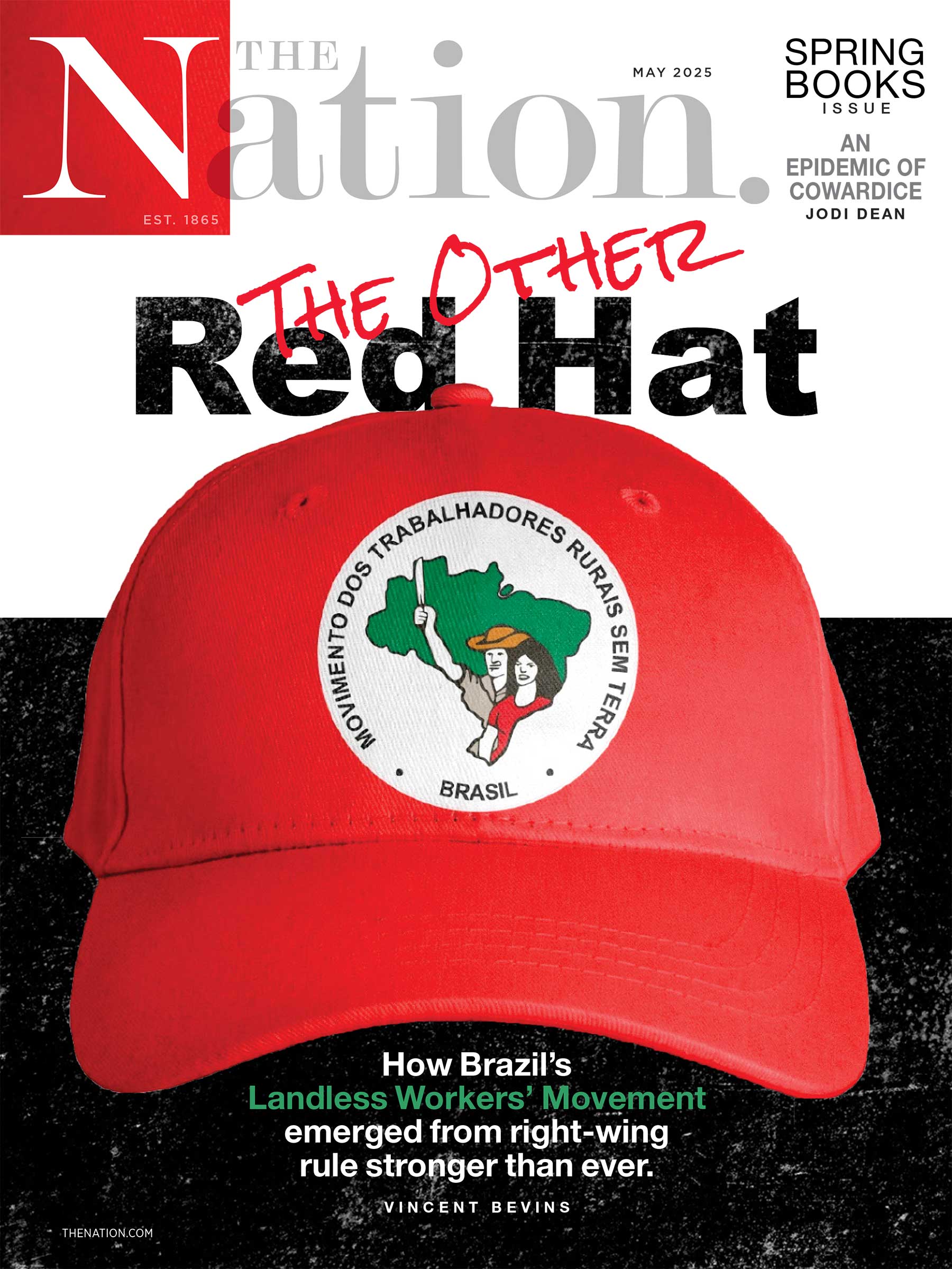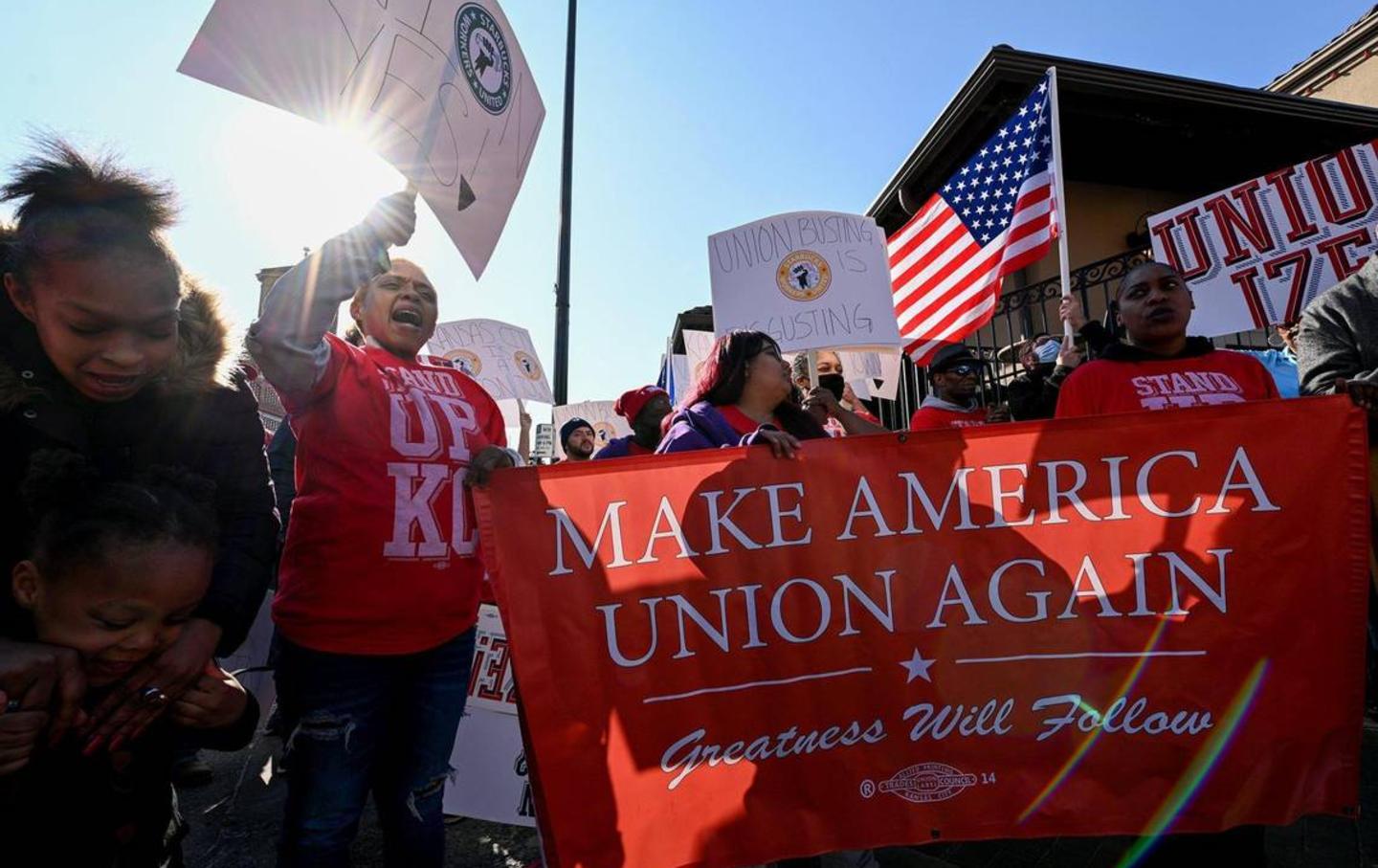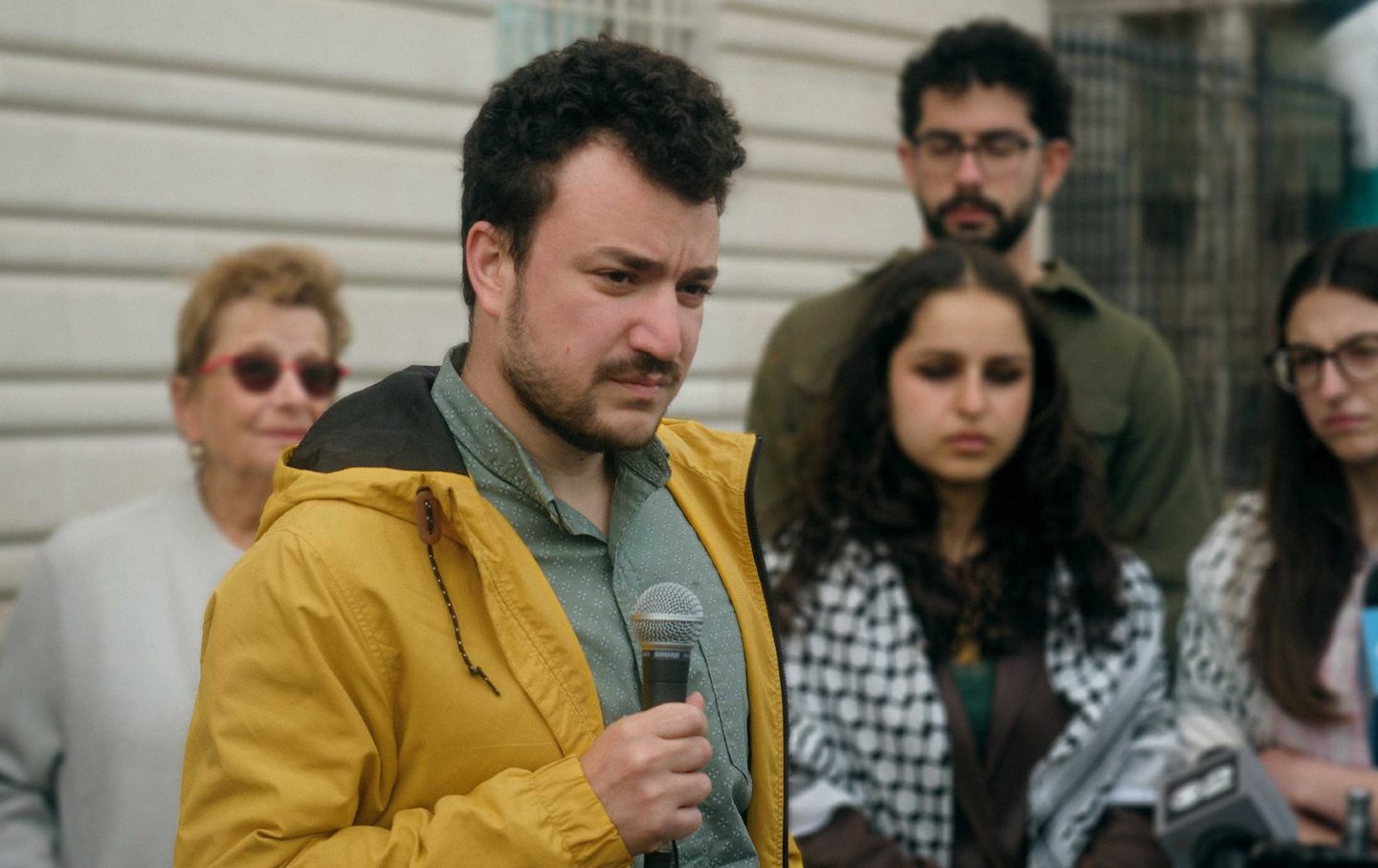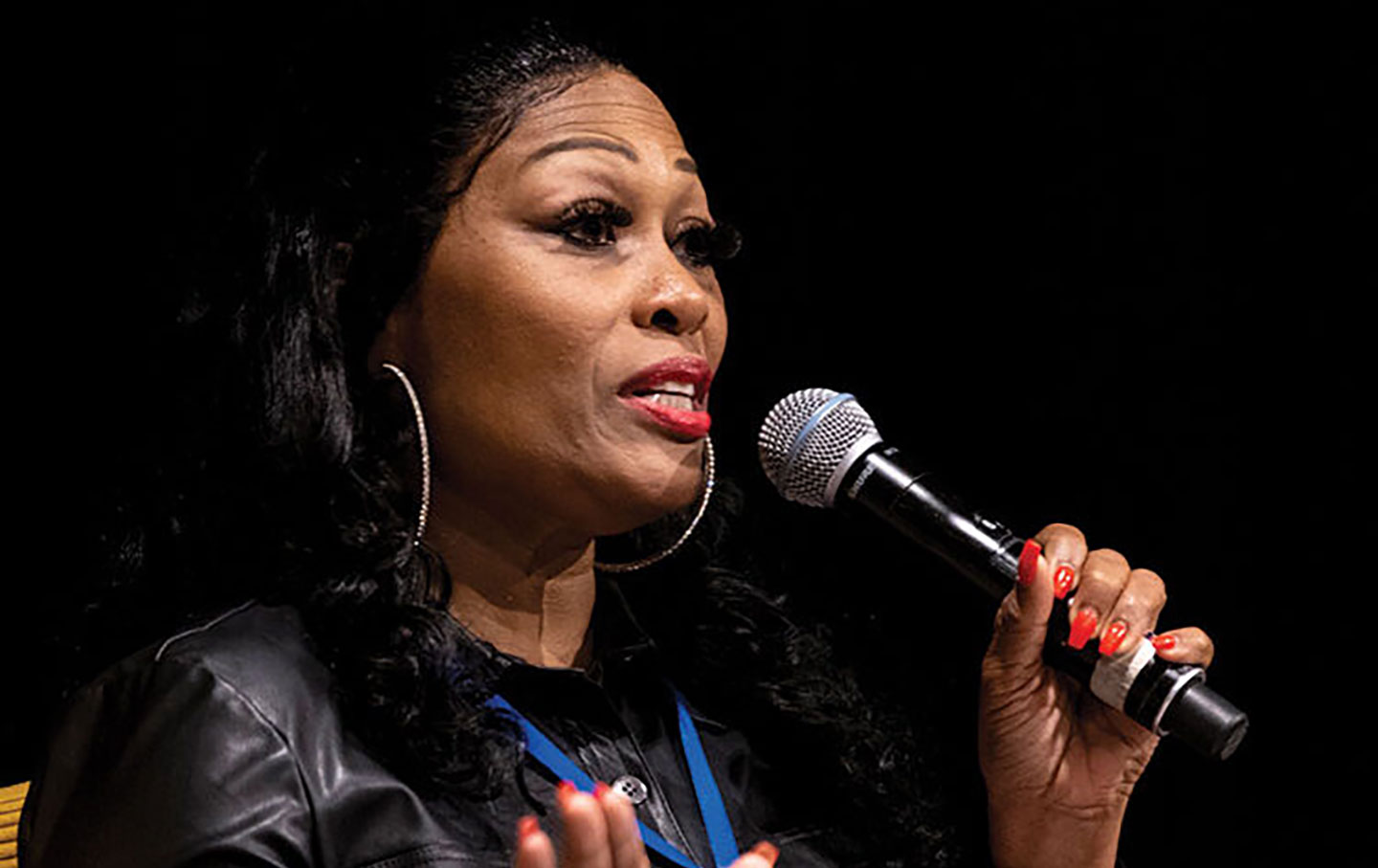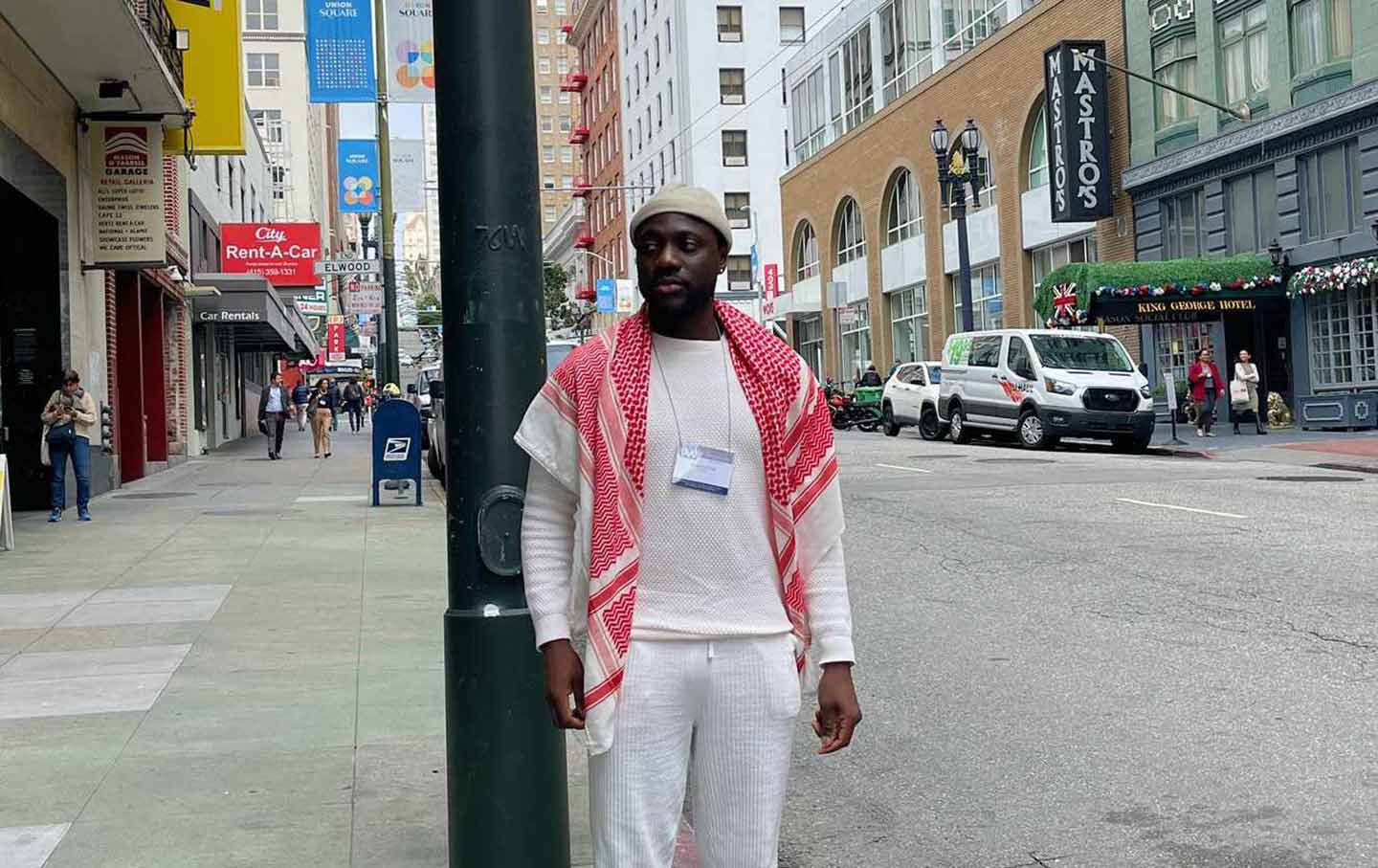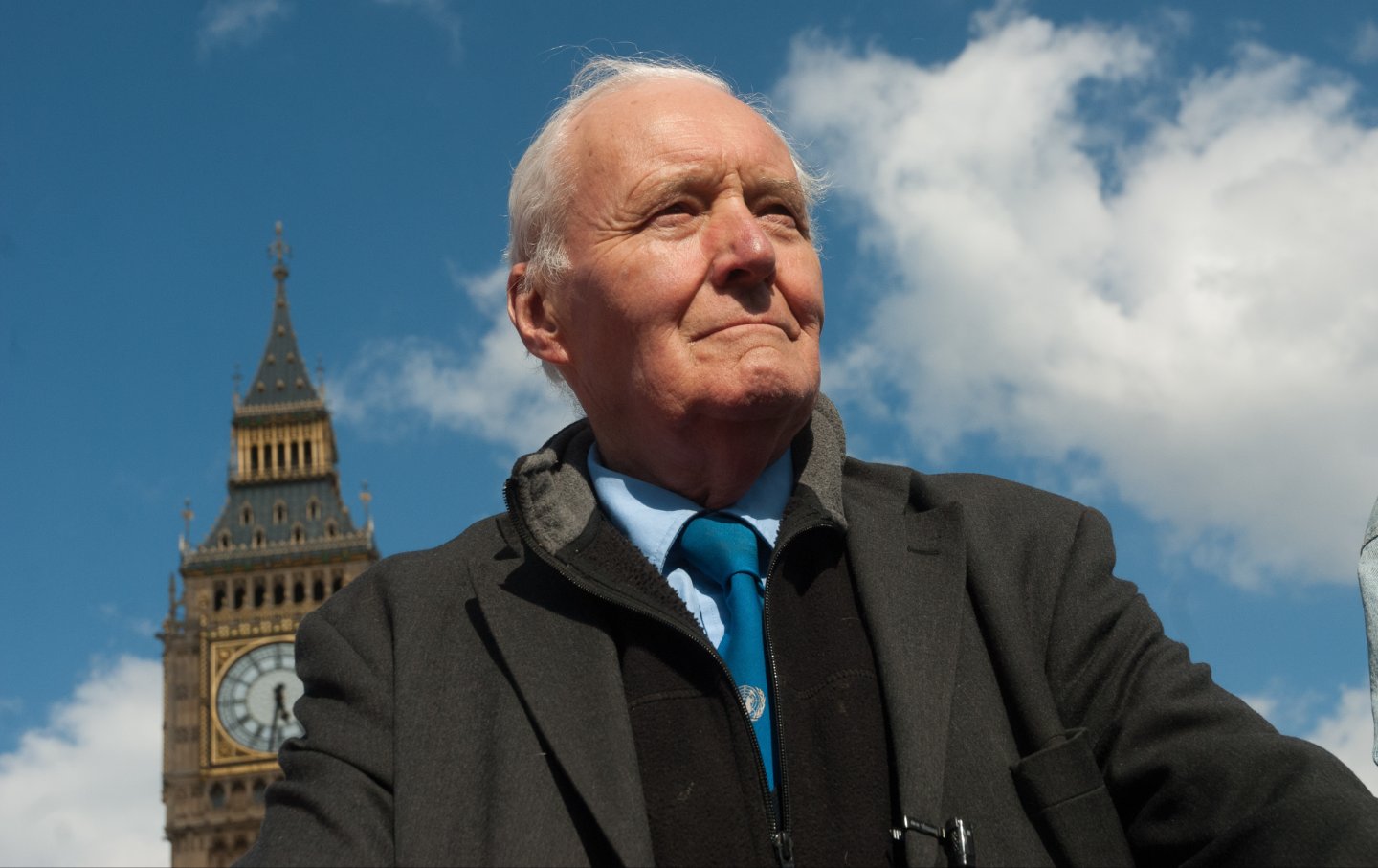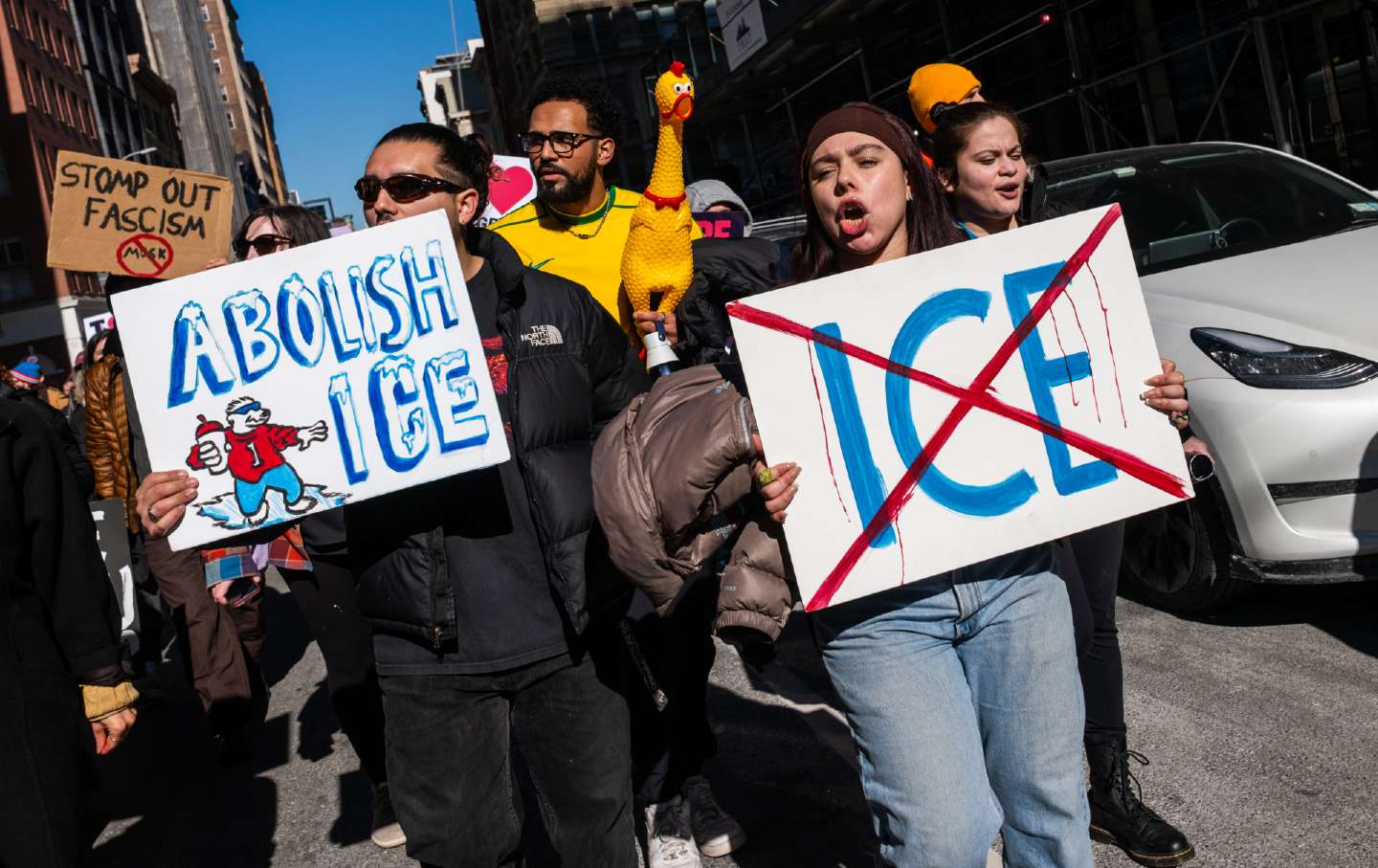What the Birth of the Sanctuary Movement Teaches Us Today
The birth of the sanctuary movement some 45 years ago can teach us a lot about how to respond to today’s attacks on immigrants.
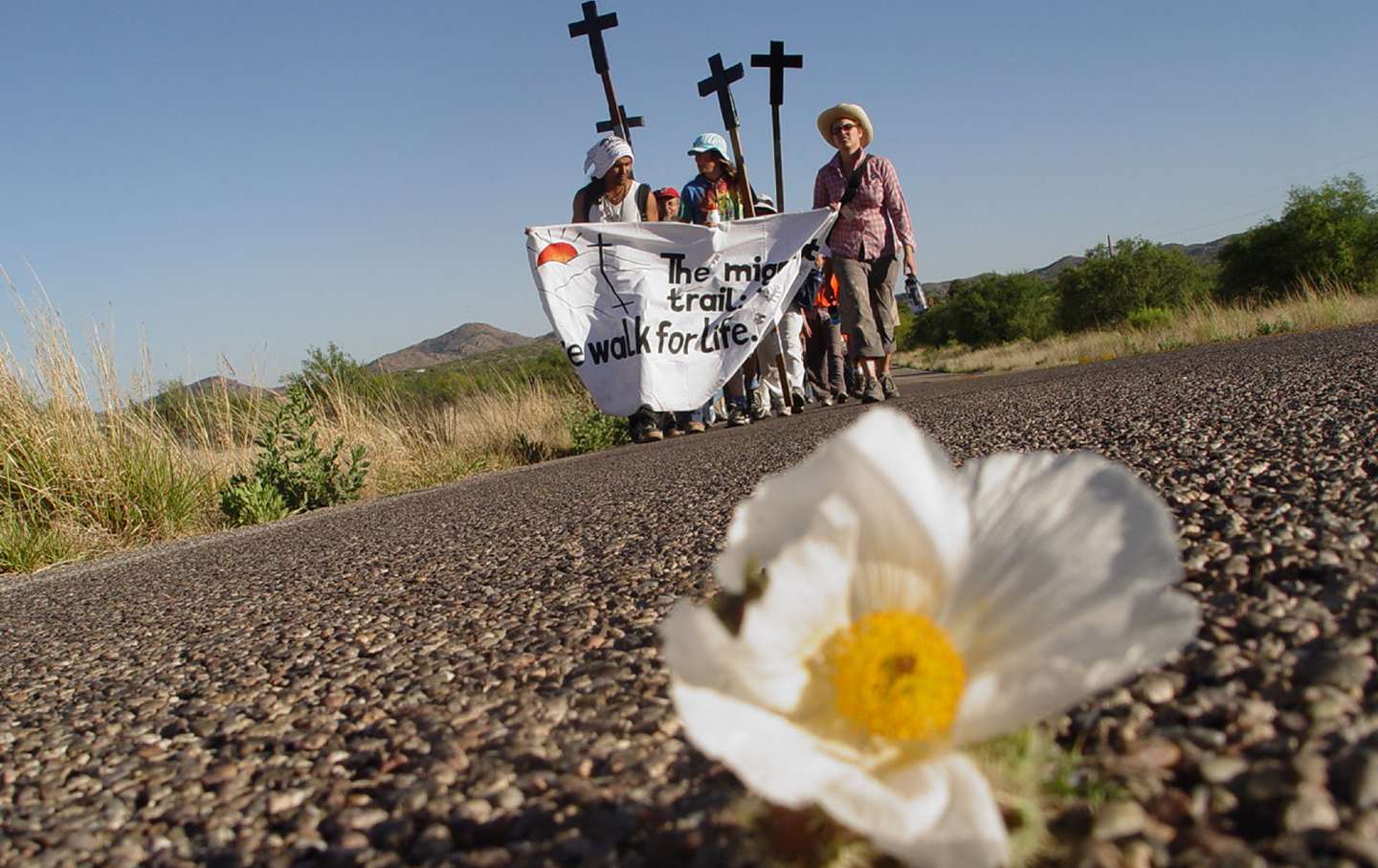
US and Mexican immigrant rights activists march through the Arizona desert to draw attention to unjust immigration policies.
(El Diario de Sonora-Antonio Flores Schroeder / AP Photo)
For much of the 20th century, almost all of the United States’ border with Mexico went virtually unpoliced, with the hostile terrain of the Sonoran and Chihuahuan deserts, as well as the rapid current of the lower Rio Grande, funnelling the vast majority of migrants toward designated ports of entry like El Paso, Laredo, and San Diego. National immigration policy may have shifted according to economic conditions—with guest workers welcomed during World War II, then expelled in the years afterward—but the border itself remained permeable.
Then, in the summer of 1980, 43 Salvadorans began their long journey to the United States by taking a bus to the city of Tapachula, in the southernmost corner of Mexico. Each of them had paid $1,200 to a pair of men named Carlos Rivera and Elias Nunez-Guardado, who operated what amounted to a travel agency for migrants out of a television repair shop in San Salvador. From Tapachula, Rivera and Nunez-Guardado chartered another bus to Mexico City, and then on to the northern state of Sonora, where the group disembarked in the border town of San Luis. Already 2,500 miles from the lush jungles of Central America, the Salvadorans sheltered from the dusty city’s triple-digit heat while Rivera and Nunez-Guardado met up with two Mexican coyotes, who agreed to guide them across the desert on the way to the group’s ultimate destination: Los Angeles. In California, three young women—two teenagers and a 20-year-old—would be met by their mother, Rosa Huezo, who had paid their way and been misled to believe the group would be arriving by airplane.
The migrants were broken into two groups of 16, each of them crowding into pickup trucks that drove east. (A third group of 11—mostly women and children—stayed behind in San Luis, either because there wasn’t enough room in the pickups or they recognized just how underprepared they were to reach the US on foot.) Just before daybreak, the two groups arrived at a restaurant in a village called Sonoyta, catching a little shut-eye in the beds of the trucks until the restaurant opened and they could all get breakfast. The Salvadorans spent the day in Sonoyta, a few of the men accepting invitations from Rivera and Nunez-Guardado to find a bit of liquid courage.
Despite Sonoyta’s position in the heart of the Altar Desert, where yellow dunes drift into peaks of sand hundreds of feet high, many of the Salvadorans still believed their guides’ assurances that it would be a short walk to Los Angeles. Waiting out the heat of the afternoon, a few lounged on bags packed with books and keepsakes from home. A couple of the women didn’t even think to change out of their high heels.
Before Rivera and Nunez-Guardado packed the group back into the pickups at nightfall, they purchased 20 gallons of water from the restaurant. Then the trucks drove about six miles back to the west, parallel to the international frontier. They met up with the Mexican coyotes not far from Quitobaquito, a small pond fed by a natural spring in Organ Pipe National Monument in the southwest corner of Arizona. After the coyotes showed the Salvadorans how to crawl through a fence that paralleled the road, the group continued due north.
By 10 the next morning, the water was gone. One man pleaded for a break from the rigorous pace set by the coyotes; a woman grew faint and had to be revived. As the migrants continued north, they kept shedding belongings and clothes. Over the course of a few hours, a trail formed: sweaters, pumps, books, photo albums. When the sun was directly overhead and the air temperature was approaching 105 degrees, the Salvadorans demanded a rest. Several people collapsed in a dry arroyo shaded by paloverde trees, hyperventilating, while a younger man doubled back to round up a few stragglers. The older gentleman who had asked to rest in the morning was nowhere to be found. One of the Mexicans coyotes gathered a few empty bottles and offered to fill them nearby, leaving with four migrants who volunteered to go along.
The Salvadorans who remained behind were so thirsty they broke off the branches of the paloverdes and tried to gnaw the supple bark, or pared the needles away from a prickly pear and chewed on the cactus’s dense flesh. One of the women began pleading for someone to simply kill her, believing a swift death would be better than slowly perishing of thirst. Rivera lunged at her and had to be restrained by another woman, whom he slugged instead. The migrants emptied their packs, looking for anything that contained even a trace of moisture. They took sips from a cologne bottle and licked shaving cream. A few peed on rags and wiped their faces, hoping the urine would rehydrate their screaming skin. When the woman who had been attacked by Rivera came to, the last Mexican coyote had disappeared and four of the other women were dead. Rivera himself lingered nearby, lapsing in and out of consciousness.
Just a mile to the east, the Mexican coyote and two of the Salvadorans stumbled on Route 85, which runs north-south through Organ Pipe National Monument. Two Border Patrol officers found them at the roadside that evening, but when they were questioned about who else they had been traveling with, the three men refused to answer. Meanwhile, two other Salvadorans had set off from the shady arroyo on their own, a man and a woman. They kept walking through the night and into the next morning, until they finally found the tiny town of Why—26 miles north of where the migrants had entered the United States. After the pair found a gas station, the man ordered eight Cokes. Given the rough shape he was in, the attendant called the authorities; after the couple was picked up, they admitted to traveling with about 30 others.
Border Patrol agents found the first batch of marooned migrants about 45 minutes later. Six men were sheltering in a gulch next to the corpses of two of their original companions. One of the officers, Hector Ochoa, poured much of his personal five-gallon jug of water over the bodies of the survivors, then soaked some of the clothing they’d stripped off their bodies, instructing them to suck on the damp fabric in order to gradually rehydrate themselves; had they attempted to drink water on its own, their bodies would have been so unprepared for the sudden rush of liquid they might have drowned. While that group was transported to safety, the rest of the Salvadorans were found under the paloverdes a short distance away—10 had died, with only three survivors lingering among the bodies.
The casualties included all three of Rose Huezo’s daughters. “It is a terrible, terrible thing,” she later told the reporter Louis Sahagún. “I wanted my daughters here because in El Salvador they are killing so many people. Now my children are dead.”
The news that 13 Salvadoran refugees had perished in the Sonoran Desert drew national headlines, making the summer of 1980 a watershed in America’s changing understanding of its southern border. Time magazine, in particular, sought to capture the sea change, writing of how this “infernal place of Gila monsters, scorching earth, mesquite and giant cactus” had long served as an entry point to America, albeit for “Spanish explorers, missionaries, [and] men drawn by California gold.” Suddenly, the demographics looked different. “They come now, still seeking the golden dream, from Mexico and Central America, an illegal but relentless stream.”
This evocation of an unstoppable foreign invasion would shape US policy over the next four decades, but back in Arizona, the initial response to the plight of the growing number of Central American refugees attempting to cross the desert was informed by humanitarian compassion, not fear. In the first hours after the refugees were rescued, John Fife, the longtime head of Tucson’s Southside Presbyterian Church, received a call from the town of Ajo. In a series of sermons Fife delivered on Southside’s history in advance of his retirement in 2009, he remembered, “The hospital asked some of us who were pastors to provide pastoral care for the survivors. We began to learn stories about death squads, and torture, and persecution of the church, and labor unions, and all those who were working with and on behalf of the poor in El Salvador.”
As more and more Salvadorans were rescued from the desert of southern Arizona in the early 1980s, Fife and other local faith leaders educated themselves about the history of what the Salvadoran American journalist Roberto Lovato has called “the tiny country of titanic sorrows,” from the genocidal campaign against its Indigenous population in the early 20th century to the financial and military support the Reagan administration was providing to the junta that was killing tens of thousands of its own citizens in the ’80s. Those same American officials insisted that the Salvadorans fleeing the violence were crossing the border only to find work, and thus did not qualify as refugees under international law. Appalled, the clergy embarked on a legal aid effort for migrants being held at detention centers near the border.
“We would file political asylum applications for them,” Fife remembered, “and we would bond out those who had been in detention the longest and bring them here to Tucson.”
When The Tucson Citizen profiled John Fife in 1979, he was pictured in a denim jacket, goatee, and thick glasses, standing in front of the simple wooden cross in Southside’s chapel, which was lined with metal folding chairs instead of pews. Southside had evolved into a radical congregation under the leadership of Fife’s predecessor, Caspar Glenn, who pushed to desegregate Tucson during the 1950s and ’60s. Fife was working to continue that tradition by fostering a congregation that actually reflected life in the city. The crowd at a typical Sunday service included “blond-haired girls in blue jeans and tennis shoes seated next to Mexican-Americans with goatees, guayabera shirts and slickly polished shoes, and with blacks, dressed in suits and ties, seated next to whites in plaid sport shirts.” Fife told the paper, “I don’t affirm an ideology. I want to correct the abuses of whatever system we have.”
As Fife was stepping in with pastoral care and legal support, an influential local activist named Jim Corbett began ferrying refugees across the border and hosting them in his apartment in Tucson, since many feared being arrested if they sought refuge at a traditional homeless shelter. Soon, Corbett’s wife approached Fife, asking him, “I’ve got 21 Salvadorans in my house—can we bring some of them to your church?” The answer was a resounding yes: After the rest of the congregation signed off on their church becoming a shelter-of-last-resort for the refugees, they moved from Corbett’s home to its pews and common rooms.
After six months, the Border Patrol learned that Southside Presbyterian was harboring undocumented migrants and warned Fife that any parishioners who helped could face legal charges. Undaunted, the church went public with its plan to continue offering sanctuary to refugees in early 1982, sending letters to the US attorney general and the heads of both the Border Patrol and the Immigration and Naturalization Service, informing them of the church’s decision to care for refugees, whatever the consequences.
“We expected to be indicted,” Fife remembered, but the government decided to ignore Southside, recognizing that prosecuting church leadership could be perilous. “A movement began. The Sanctuary Movement. Southside Church provided the model for other congregations, Protestant and Catholic and Jewish congregations, who were equally morally and ethically troubled by our government’s policy here on the border.”
Within two years, 287 churches had declared themselves as sanctuaries: They would provide shelter to refugees, even if doing so was illegal. Those churches were soon joined by more than a dozen cities that passed ordinances instructing local law enforcement officials to neither ask residents about their immigration status nor cooperate with federal immigration authorities conducting enforcement operations. In an apparent effort to stem the movement’s momentum, immigration officers arrested an activist in South Texas for transporting three Salvadoran refugees within the United States; in protest, Rabbi Joseph Weizenbaum organized a Freedom Seder at Tucson’s Temple Emanu-El, and volunteers drove 80 Central Americans from Southside Presbyterian to the synagogue in a two-mile convoy. In 1985, 16 Sanctuary Movement participants were indicted by a federal grand jury on charges of “alien smuggling,” including Fife and Corbett, along with Ramon Quinones, a Catholic priest from Nogales, and three nuns.
If federal officials thought the prosecutions would end the Sanctuary Movement, they were wrong: Over the course of the trial, the number of participating congregations more than doubled. All eight of the activists who were eventually found guilty were given probation by a judge who acknowledged that, though they had broken the law, they had “done so because of humanitarian concerns.”
In 1987, Arizona Senator Dennis DeConcini and Massachusetts Representative Joe Moakley, both Democrats, introduced legislation to prohibit the deportation of Salvadoran and Nicaraguan refugees already in the United States, citing the 60,000 Salvadorans who had died in that nation’s civil war and the human rights abuses of both the Sandinista government in Nicaragua and the conservative, US-backed Contras that opposed them. Three years later, Congress created the designation of Temporary Protected Status for certain immigrants and extended it to the half a million undocumented Salvadorans then living in the country. After years of uncertainty, practically all of the refugees who had been offered safe haven by the sanctuary movement could begin to build new lives for themselves in the United States.
Over the previous decade, around 13,000 Central Americans had been sheltered by Southside Presbyterian. “I don’t know how we provided hospitality to all those people,” Fife sermonized in 2009. “I know we didn’t do it all by ourselves, it took a whole community to do that.”
After the creation of Temporary Protected Status, many thought the Sanctuary Movement had run its course. That changed with a steep rise in migrants from Mexico traveling through the deserts of southern Arizona in the mid 1990s. But even without a national spotlight on its work, Southside Presbyterian remained at the forefront of the struggle to support the undocumented. After the Clinton administration clamped down on the two largest ports of entry during Operation Hold the Line in El Paso and Operation Gatekeeper in San Diego, more and more migrants were incentivized to try their luck along the 600 miles of desert separating the two cities. While apprehensions in those urban sectors dropped by 70 percent, arrests in the region south of Tucson rose by a factor of six.
Popular
“swipe left below to view more authors”Swipe →In response, Fife helped found a group called Humane Borders in 2000, which established and maintained water stations across the Arizona borderlands. After 14 Mexicans died attempting the crossing in 2001, Humane Borders held a funeral at the First Christian Church on Speedway Boulevard. The group’s president, Robin Hoover, eulogized them by saying, “We are here because migrants are being systematically herded onto death trails.” In 2004, another group, No More Deaths/No Más Muertes, joined the campaign, and since then, both groups’ volunteers have played a high-stakes cat-and-mouse game with Border Patrol officers, who typically drain jugs of water whenever they find them.
In his memoir about working for the Border Patrol, Francisco Cantu wrote that the reason officers “slash their bottles and drain their water into the dry earth, that we dump their backpacks and pile their food and clothes to be crushed and pissed on and stepped over, strewn across the desert and set ablaze,” was in hopes that migrants, once they “find their stockpiles ransacked and stripped,” will realize “it’s hopeless to continue. They’ll save themselves and struggle toward the nearest highway or dirt road to flag down some passing agent.”
Sometimes, the strategy works. Other times, it doesn’t, and migrants stranded without food or water die. Between 2001 and 2021, the Border Patrol’s budget expanded from $1.1 billion to $4.8 billion. Over the same period, an investigation from the Arizona Daily Star’s Curt Prendergast and Alex Devoid found that, while apprehensions plummeted by 90 percent in the Tucson sector, nearly 10 times as many human remains were being found in the desert every year.
“The journey has grown more dangerous over the years, due in part to walls and barriers funneling migrants into remote areas. Today, remains are found an average of seventeen miles from towns,” Prendergast and Devoid wrote. “Exposure to the elements, particularly heat, is the most common cause of death, leading to 1,390 deaths and likely many of the 1,866 sets of skeletal remains where cause of death was undetermined.”
Over the past 40 years, a bipartisan desire to limit the number of undocumented migrants entering the United States has transformed the desert borderlands into a fully militarized space. Death has become, as a matter of policy, the ultimate deterrent. And yet, on the ground, the denizens of communities like Tucson, El Paso, and Juárez understand that refugees will brave any conditions if they believe it can help them forge a better life. In cities where so many family histories reflect the same aspiration, migration is understood not as a crisis but as a manifestation of the natural striving of impoverished and disposed peoples toward safety and opportunity.
The need for a rejuvenated movement to defend the undocumented and other immigrants has only grown since Donald Trump resumed office. Over the past two months, Trump has deployed 1,600 soldiers to the southern border, begun transferring detained migrants to Guantánamo Bay, and withdrawn Temporary Protected Status from roughly 350,000 Venezuelan refugees and half a million Haitians, all while threatening to cut federal funding for cities and states with sanctuary policies. With the Senate passing a budget that includes $175 billion to further militarize the border and set up internment camps large enough to execute Trump’s promised mass deportations, the current assault on America’s immigrants won’t be ending anytime soon.
Against this backdrop, Tucson has once again emerged as an epicenter of advocacy for the undocumented. The local chapter of the Party for Socialism and Liberation has been particularly active, organizing regular rallies in Amory Park and teaching community members how to mobilize against mass deportations. Meanwhile, Coalición de Derechos Humanos is maintaining a rapid response hotline for Tucsonenses threatened by ICE or other federal authorities.
While the Trumpian ethos of overt xenophobia and military suppression has bullied politicians across the spectrum into silence or, far worse, complicity, the people of Tucson—like those in so many communities across the borderlands of the Southwest—are uncowed. When the city’s ABC affiliate covered a recent protest at the Southside’s Rudy Garcia Park, one of the organizers involved with Derechos Humanos, María Carrasco, issued a succinct call for Americans in Tucson and beyond to mobilize on behalf of migrants: “If they’re going to bombard immigrants then we’re going to support everybody. We’re gonna scream and keep doing this until something changes.”
Hold the powerful to account by supporting The Nation
The chaos and cruelty of the Trump administration reaches new lows each week.
Trump’s catastrophic “Liberation Day” has wreaked havoc on the world economy and set up yet another constitutional crisis at home. Plainclothes officers continue to abduct university students off the streets. So-called “enemy aliens” are flown abroad to a mega prison against the orders of the courts. And Signalgate promises to be the first of many incompetence scandals that expose the brutal violence at the core of the American empire.
At a time when elite universities, powerful law firms, and influential media outlets are capitulating to Trump’s intimidation, The Nation is more determined than ever before to hold the powerful to account.
In just the last month, we’ve published reporting on how Trump outsources his mass deportation agenda to other countries, exposed the administration’s appeal to obscure laws to carry out its repressive agenda, and amplified the voices of brave student activists targeted by universities.
We also continue to tell the stories of those who fight back against Trump and Musk, whether on the streets in growing protest movements, in town halls across the country, or in critical state elections—like Wisconsin’s recent state Supreme Court race—that provide a model for resisting Trumpism and prove that Musk can’t buy our democracy.
This is the journalism that matters in 2025. But we can’t do this without you. As a reader-supported publication, we rely on the support of generous donors. Please, help make our essential independent journalism possible with a donation today.
In solidarity,
The Editors
The Nation
